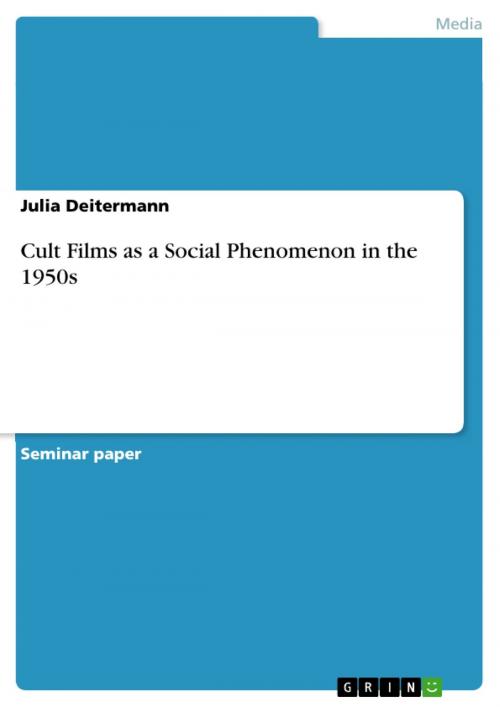| Author: | Julia Deitermann | ISBN: | 9783638546249 |
| Publisher: | GRIN Publishing | Publication: | September 18, 2006 |
| Imprint: | GRIN Publishing | Language: | English |
| Author: | Julia Deitermann |
| ISBN: | 9783638546249 |
| Publisher: | GRIN Publishing |
| Publication: | September 18, 2006 |
| Imprint: | GRIN Publishing |
| Language: | English |
Seminar paper from the year 2004 in the subject Film Science, grade: A, San Diego State University, course: Cult Films - Weirdly Dramatic, 9 entries in the bibliography, language: English, abstract: The decade of the 1950s predominantly recalls ideas of conventionalism, conformity and gender boundaries. The home played an important role as an oasis of peace, retreat and security, thus the era is shaped by the widespread ideal of the suburban family. However, the notion of conformity and the idyll of the so-called 'nuclear family' served as points of attack for filmmakers as society's indifferent and passive life was seen as the basis for their loss of individuality and free will. As a result, movies put emphasis on the fragility of society and the reversal of moral ideals, and filmmakers called for a more active participation in social and political life. Above all, people who lived in the idyll of peaceful suburb communities were afraid of an infiltration of their own individuality and of the dissolving of their integrity, a process which could in their opinion be provoked both physically, for example by the nuclear bomb, and mentally, that is by the spread of Communism. Consequently, the period following World War II was predominantly shaped by the influence of the Cold War which presented a seemingly peaceful situation but created great paranoia among people, such as the fear of the attack of hidden evil. The filmmakers' way of dealing with the new situation was the introduction of science fiction horror movies which responded to the existing fear of an offensive by an external enemy. The enemy generally embodied the Communist threat and found its common representation in alien invasions. In the following, I will analyze the significance of cult films as a social phenomenon in the 1950s and thereby draw on films likeInvasion of the Body Snatchers, Invaders from Mars, The Incredible Shrinking Man,andGlen or Glenda?.In doing so, I will examine Cold War paranoia and the fear of the loss of integrity which dominated both people and film industry in the fifties. Due to the rising boom of the science fiction and horror genre, the 1950s can be referred to as the 'decade of the monster movie'. The establishment of drive-in theaters increased people's paranoia as outdoor cinemas reinforced the threat of an invasion by lacking the domestic security found indoors. Moreover, they responded to the demands of a new teenage culture of rebellion that praised their independence and lived out their adventures. One of the classic monster movies that was a huge success in drive-in theaters was Don Siegel'sInvasion of the Body Snatchers,produced in 1956. [...]
Seminar paper from the year 2004 in the subject Film Science, grade: A, San Diego State University, course: Cult Films - Weirdly Dramatic, 9 entries in the bibliography, language: English, abstract: The decade of the 1950s predominantly recalls ideas of conventionalism, conformity and gender boundaries. The home played an important role as an oasis of peace, retreat and security, thus the era is shaped by the widespread ideal of the suburban family. However, the notion of conformity and the idyll of the so-called 'nuclear family' served as points of attack for filmmakers as society's indifferent and passive life was seen as the basis for their loss of individuality and free will. As a result, movies put emphasis on the fragility of society and the reversal of moral ideals, and filmmakers called for a more active participation in social and political life. Above all, people who lived in the idyll of peaceful suburb communities were afraid of an infiltration of their own individuality and of the dissolving of their integrity, a process which could in their opinion be provoked both physically, for example by the nuclear bomb, and mentally, that is by the spread of Communism. Consequently, the period following World War II was predominantly shaped by the influence of the Cold War which presented a seemingly peaceful situation but created great paranoia among people, such as the fear of the attack of hidden evil. The filmmakers' way of dealing with the new situation was the introduction of science fiction horror movies which responded to the existing fear of an offensive by an external enemy. The enemy generally embodied the Communist threat and found its common representation in alien invasions. In the following, I will analyze the significance of cult films as a social phenomenon in the 1950s and thereby draw on films likeInvasion of the Body Snatchers, Invaders from Mars, The Incredible Shrinking Man,andGlen or Glenda?.In doing so, I will examine Cold War paranoia and the fear of the loss of integrity which dominated both people and film industry in the fifties. Due to the rising boom of the science fiction and horror genre, the 1950s can be referred to as the 'decade of the monster movie'. The establishment of drive-in theaters increased people's paranoia as outdoor cinemas reinforced the threat of an invasion by lacking the domestic security found indoors. Moreover, they responded to the demands of a new teenage culture of rebellion that praised their independence and lived out their adventures. One of the classic monster movies that was a huge success in drive-in theaters was Don Siegel'sInvasion of the Body Snatchers,produced in 1956. [...]















